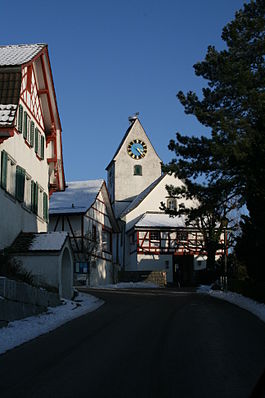Buchs, Zurich
| Buchs | ||
|---|---|---|

Swiss Reformed church
|
||
|
||
| Coordinates: 47°28′N 8°26′E / 47.467°N 8.433°ECoordinates: 47°28′N 8°26′E / 47.467°N 8.433°E | ||
| Country | Switzerland | |
| Canton | Zürich | |
| District | Dielsdorf | |
| Area | ||
| • Total | 5.84 km2 (2.25 sq mi) | |
| Elevation | 442 m (1,450 ft) | |
| Population (Dec 2015) | ||
| • Total | 6,269 | |
| • Density | 1,100/km2 (2,800/sq mi) | |
| Postal code | 8107 | |
| SFOS number | 0083 | |
| Surrounded by | Boppelsen, Dällikon, Dänikon, Dielsdorf, Niederhasli, Otelfingen, Regensberg, Regensdorf | |
| Website |
www SFSO statistics |
|
Buchs is a municipality in the district of Dielsdorf in the canton of Zürich in Switzerland.
Buchs is first mentioned in 870 as Pusaha. In 1219 it was mentioned as Buhsa.
Buchs has an area of 5.9 km2 (2.3 sq mi). Of this area, 50.3% is used for agricultural purposes, while 26.9% is forested. Of the rest of the land, 21.8% is settled (buildings or roads) and the remainder (1%) is non-productive (rivers, glaciers or mountains).
The municipality is located in the Furttal on the southern flank of the Lägern ridge.
Buchs has a population (as of 31 December 2015) of 6,269. As of 2007[update], 19.0% of the population was made up of foreign nationals. Over the last 10 years the population has grown at a rate of 27.3%. Most of the population (as of 2000[update]) speaks German (88.6%), with Italian being second most common ( 2.7%) and Albanian being third ( 1.7%).
In the 2007 election the most popular party was the SVP which received 46.6% of the vote. The next three most popular parties were the SPS (14.2%), the FDP (12.4%) and the CSP (9.8%).
The age distribution of the population (as of 2000[update]) is children and teenagers (0–19 years old) make up 26.2% of the population, while adults (20–64 years old) make up 66.9% and seniors (over 64 years old) make up 7%. The entire Swiss population is generally well educated. In Buchs about 80.9% of the population (between age 25-64) have completed either non-mandatory upper secondary education or additional higher education (either university or a Fachhochschule).
...
Wikipedia




